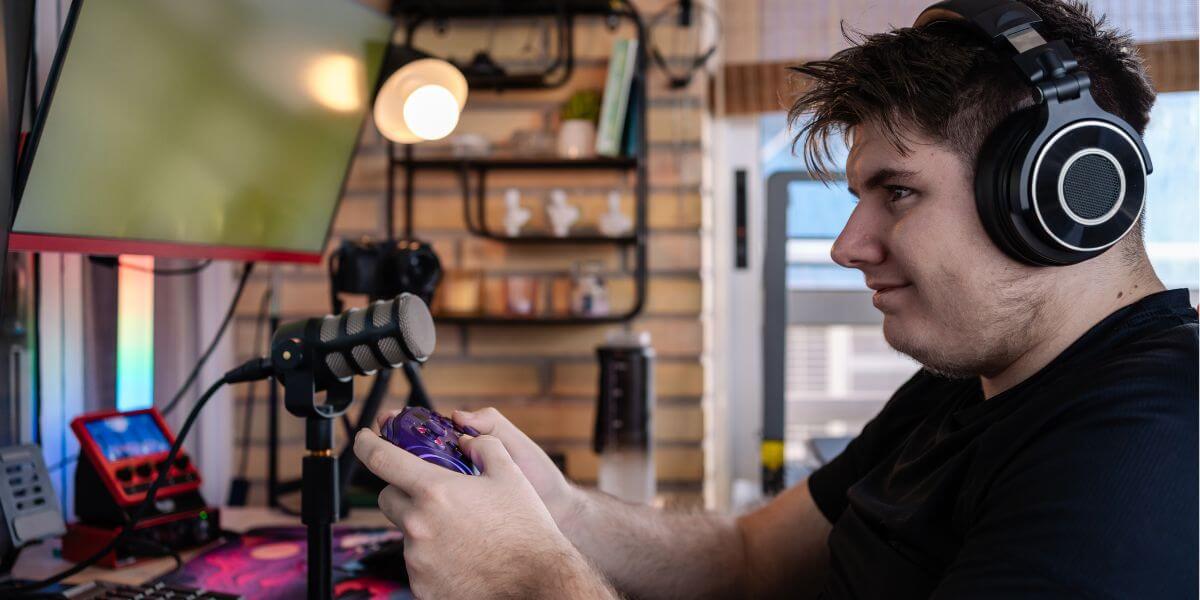Lower your internet bill
61% of people overpay for their internet.
Are you one of them?
Unlock exclusive offers in your area!
Call now
[tel]Enter zip code
1 Star is Poor & 5 Stars is Excellent.
* Required
Written by Sam Watanuki - Pub. Aug 12, 2025 / Updated Aug 11, 2025
Table of Contents
Are you happy with your Internet service?
About the author
Gaming has evolved dramatically since the early days of simple arcade games. What began as a solitary hobby has transformed into a massive social and entertainment industry, with live streaming becoming one of its most significant developments. Originally called Justin.tv, Twitch launched in 2011 [1] and totally changed how gamers share their experiences, growing from a niche platform to the dominant force in game streaming with over 140 million monthly active users as of 2024 [2].
The rise of content creators like Ninja, Pokimane, and xQc (just to name a few) has shown that streaming isn’t just a hobby — it’s become a legitimate career path. However, success requires more than just gaming skills. Knowing how to stream on Twitch effectively involves technical knowledge, proper equipment, and crucially, having the right gaming internet connection to support your broadcasts.
61% of people overpay for their internet.
Are you one of them?
Unlock exclusive offers in your area!
Call now
[tel]Enter zip code
Before getting into platform-specific instructions, it’s important to understand the fundamental requirements.Streaming requires three key components:
The internet connection aspect cannot be overstated. Unlike regular gaming, which primarily uses download speeds, streaming heavily relies on upload speeds. When you stream on twitch, you’re constantly sending video data to Twitch’s servers, which then distribute it to your viewers worldwide. This process demands consistent, high-quality upload bandwidth that many standard internet plans struggle to provide.
According to Twitch’s official broadcasting guidelines [3], streaming at 1080p resolution requires upload speeds of at least 6-8 Mbps, while 720p streaming needs 3-5 Mbps. However, these are minimum requirements — having additional bandwidth ensures stream stability and accounts for other devices using your network simultaneously.

How Has Internet Infrastructure Impacted Streaming Quality?
Streaming technology has evolved significantly alongside improvements in internet infrastructure. In streaming’s early days around 2007-2010, most content creators were limited to 480p or lower resolutions due to bandwidth constraints [4]. The widespread adoption of fiber internet and improved cable infrastructure has enabled today’s standard of 1080p streaming, with 4K streaming becoming increasingly accessible.
Internet providers have recognized this shift in consumer needs. Major companies like Verizon Fios, Xfinity, and AT&T now market plans specifically highlighting upload speeds, a metric that was rarely emphasized before the streaming boom. This evolution reflects how streaming has fundamentally changed what consumers need from their internet service.
Streaming on Twitch has become a popular way for gamers, creatives, and entertainers to share their passions with a global audience. Here’s how to do it yourself:
Computer streaming offers the most flexibility and highest quality options. The process involves using broadcasting software like OBS Studio (Open Broadcaster Software), which has become the industry standard since its release in 2012 [5].
Audio configuration is equally important.
Gaming consoles have streamlined the streaming process significantly compared to earlier generations. Xbox Series X/S and PlayStation 5 include built-in streaming capabilities, eliminating the need for external capture cards.
Mobile streaming has also gained significant traction, particularly for games like Minecraft, Among Us, and mobile-exclusive titles. The official Twitch mobile app includes streaming functionality that’s surprisingly good for on-the-go broadcasting.
Open the Twitch app and tap the camera icon, then select “Stream Games." Choose your game category, configure your stream title and tags, and tap “Go Live." The app automatically handles video encoding and provides on-screen controls for managing your broadcast.

What Internet Connection Do You Need for Quality Streaming?
Your internet connection forms the foundation of successful streaming. While gaming typically requires minimal bandwidth — often just 3-5 Mbps download — streaming demands substantial upload bandwidth that varies based on your quality settings.
The relationship between bitrate (data transmission rate) and internet speed is crucial to understand. Streaming at 1080p/60fps typically requires a bitrate of 6000 Kbps (6 Mbps), but you should aim for more bandwidth available than your bitrate setting. This buffer accounts for network fluctuations and other internet usage in your household.
Fiber internet connections provide the most reliable streaming experience due to their symmetrical upload and download speeds. Cable internet can work well but often has significantly lower upload speeds compared to download speeds. DSL connections typically struggle with streaming due to limited upload bandwidth, especially for higher quality broadcasts.
Choosing the right internet provider can make or break your streaming career. Different providers offer varying upload speeds, latency characteristics, and reliability levels that directly impact stream quality.
When evaluating internet providers, prioritize upload speed over download speed for streaming purposes. Compare internet providers in your area by examining their upload speed offerings, not just their advertised download speeds. Many providers market “gig speed" plans while offering only 35 Mbps upload, which limits streaming quality.
Reliability is equally important. Stream interruptions due to connection instability can cause viewers to leave and negatively impact your channel’s growth. Research provider reliability in your specific area by checking local forums, social media groups, and review sites for real user experiences.
Internet availability varies significantly by location, making it essential to research options in your specific area. Rural areas often have limited choices, while urban areas typically offer multiple providers with competitive plans.
Use online comparison tools to evaluate internet comparison options systematically. Look beyond advertised speeds to examine actual performance data, customer satisfaction ratings, and pricing structures. Many providers offer promotional rates that increase significantly after the initial contract period.
Consider calling providers directly to discuss streaming-specific needs. Some companies offer prioritized bandwidth for content creators or business-class plans with enhanced support and service level agreements. These options often cost more but provide better reliability and performance for professional streamers.
When comparing internet plans, calculate the total cost of ownership, including equipment rental fees, installation charges, and any data caps or overage fees. Some providers impose data limits that can impact streamers who broadcast for many hours daily.
Internet prices vary dramatically based on location, competition level, and infrastructure availability. Urban areas typically offer lower prices due to competition, while rural areas may face higher costs and limited options. Government initiatives and infrastructure investments continue expanding high-speed internet access, gradually improving options in underserved areas.
Beyond internet connectivity, successful streaming requires attention to several technical aspects. Audio quality often matters more than video quality to viewers — invest in a decent microphone before upgrading your camera. The Shure MV7 [6] and Audio-Technica AT2020USB+ are popular choices among streamers for their quality and ease of use.
Lighting significantly impacts video quality, especially for webcam footage. A simple ring light or softbox can dramatically improve your appearance on stream. Position lighting in front of you to avoid harsh shadows and create a professional appearance.
Stream management tools like Streamlabs or StreamElements provide overlays, alerts, and chat management features that enhance viewer experience. These platforms integrate with OBS and offer templates designed specifically for gaming content.

Start Your Streaming Journey with the Right Foundation
Success on Twitch starts with having the right internet foundation. While great content and engaging personality matter enormously, technical issues from poor internet connectivity can derail even the most entertaining streams. Your viewers expect consistent, high-quality broadcasts, and meeting those expectations begins with choosing the best internet providers in your area.
Don’t let inadequate internet hold back your streaming ambitions. Whether you’re planning casual gaming sessions with friends or building toward that coveted Twitch Partnership, having reliable, high-speed internet removes technical barriers and lets you focus on creating amazing content. Compare internet plans in your area today to ensure your connection can support your streaming goals from day one.
Enter your ZIP code here to see all available internet options in your neighborhood.
For 720p streaming at 30fps, you need at least 3-4 Mbps upload speed. For 1080p at 60fps, aim for 6-8 Mbps upload speed. Always aim to have more bandwidth than your target bitrate to ensure stability. Download speeds matter less for streaming — focus on upload speed when choosing internet plans.
Traditional satellite internet typically has high latency and data caps that make streaming difficult. However, newer services like Starlink offer lower latency that can support streaming. Mobile hotspots work for short streams but often have data limitations and inconsistent speeds that affect quality.
OBS Studio is free, highly customizable, and preferred by experienced streamers. Twitch Studio offers simpler setup with built-in templates but less customization. XSplit and Wirecast are paid options with professional features. Console built-in streaming is easiest but offers fewer customization options.
Use Twitch’s built-in stream health tools and run test streams to check stability. Monitor your bitrate consistency and dropped frame rates in OBS. Run speed tests during peak usage hours when you plan to stream. Consider using Twitch Inspector to analyze your connection quality before going live.
[1] Twitch. “16 Years Of Twitch."
[2] DemandSage. “Twitch Statistics 2025 Users & Growth Data]."
[3] Twitch. “Broadcasting Guidelines."
[4] Reddit. “Why do YouTube videos in 2007 to 2010 were such low quality?"
[5] OBS. “Open Broadcaster Software."
[6] GamingPizza. “REVIEW: Shure MV7 Limited Edition White Noir Microphone."
About the author
Congratulations, you qualify for deals on internet plans.
Speak with our specialists to access all local discounts and limited time offers in your area.
[tel]61% of people overpay for their internet.
Are you one of them?
Unlock exclusive offers in your area!
Call now
[tel]Enter zip code